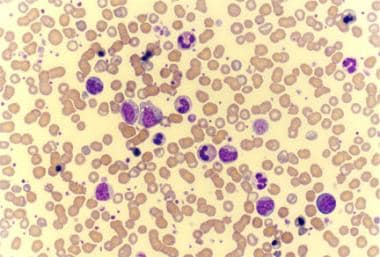O'Brien SG, Guilhot F, Larson RA. Imatinib compared with interferon and low-dose cytarabine for newly diagnosed chronic-phase chronic myeloid leukemia. N Engl J Med. 2003 Mar 13. 348(11):994-1004. [QxMD MEDLINE Link].
Vardiman JW. The World Health Organization (WHO) classification of the myeloid neoplasms. Blood. 2002. 100:2299-2300. [QxMD MEDLINE Link]. [Full Text].
Chaiter Y, Brenner B, Aghai E, Tatarsky I. High incidence of myeloproliferative disorders in Ashkenazi Jews in northern Israel. Leuk Lymphoma. 1992 Jun. 7 (3):251-5. [QxMD MEDLINE Link].
Arber DA, Orazi A, Hasserjian R, Thiele J, Borowitz MJ, Le Beau MM, et al. The 2016 revision to the World Health Organization classification of myeloid neoplasms and acute leukemia. Blood. 2016 May 19. 127 (20):2391-405. [QxMD MEDLINE Link]. [Full Text].
Baxter EJ, Scott LM, Campbell PJ. Acquired mutation of the tyrosine kinase JAK2 in human myeloproliferative disorders. Lancet. 2005 Mar 19-25. 365(9464):1054-61. [QxMD MEDLINE Link].
James C, Ugo V, Le Couedic JP. A unique clonal JAK2 mutation leading to constitutive signalling causes polycythaemia vera. Nature. 2005 Apr 28. 434(7037):1144-8. [QxMD MEDLINE Link].
Sonbol MB, Firwana B, Zarzour A, Morad M, Rana V, Tiu RV. Comprehensive review of JAK inhibitors in myeloproliferative neoplasms. Ther Adv Hematol. 2013 Feb. 4(1):15-35. [QxMD MEDLINE Link]. [Full Text].
Ursuleac I, Colita A, Adam T, Jardan C, Ilea A, Coriu D. The concomitant occurrence of JAK2V617F mutation and BCR/ABL transcript with phenotypic expression - an overlapping myeloproliferative disorder or two distinct diseases? - case report. J Med Life. 2013 Mar 15. 6(1):34-7. [QxMD MEDLINE Link]. [Full Text].
Mesa RA, Powell H, Lasho T, Dewald G, McClure R, Tefferi A. JAK2(V617) and leukemic transformation in myelofirbrosis with myeloid metaplasia. Leuk Res. 2006/11. 30 (11):1457-60.
Anand S, Stedham F, Beer P, et al. Effects of the JAK2 mutation on the hematopoietic stem and progenitor compartment in human myeloproliferative neoplasms. Blood. 2011 Jul 7. 118(1):177-81. [QxMD MEDLINE Link].
Pardanani A, Brockman SR, Paternoster SF. FIP1L1-PDGFRA fusion: prevalence and clinicopathologic correlates in 89 consecutive patients with moderate to severe eosinophilia. Blood. 2004 Nov 15. 104(10):3038-45. [QxMD MEDLINE Link]. [Full Text].
Levine RL. Another Piece of the Myeloproliferative Neoplasms Puzzle. N Engl J Med. 2013 Dec 10. [QxMD MEDLINE Link].
Nangalia J, Massie CE, Baxter EJ, Nice FL, Gundem G, Wedge DC, et al. Somatic CALR Mutations in Myeloproliferative Neoplasms with Nonmutated JAK2. N Engl J Med. 2013 Dec 10. [QxMD MEDLINE Link].
Nelson R. New Gene Mutation Found in Myeloproliferative Neoplasms. Medscape Medical News. Available at http://www.medscape.com/viewarticle/817704. Accessed: December 16, 2013.
Donato NJ, Talpaz M. Clinical use of tyrosine kinase inhibitors: therapy for chronic myelogenous leukemia and other cancers. Clin Cancer Res. 2000 Aug. 6(8):2965-6. [QxMD MEDLINE Link].
Bjorkholm M, Derolf AR, Hultcrantz M, et al. Treatment-related risk factors for transformation to acute myeloid leukemia and myelodysplastic syndromes in myeloproliferative neoplasms. J Clin Oncol. 2011 Jun 10. 29(17):2410-5. [QxMD MEDLINE Link]. [Full Text].
American Cancer Society. Cancer Facts & Figures 2019. Cancer.org. Available at https://www.cancer.org/content/dam/cancer-org/research/cancer-facts-and-statistics/annual-cancer-facts-and-figures/2018/cancer-facts-and-figures-2018.pdf. 2019; Accessed: February 24, 2019.
Johansson P, Kutti J, Andreasson B. Trends in the incidence of chronic Philadelphia chromosome negative (Ph-) myeloproliferative disorders in the city of Goteborg, Sweden, during 1983-99. J Intern Med. 2004 Aug. 256(2):161-5.
Kutti J, Ridell B. Epidemiology of the myeloproliferative disorders: essential thrombocythaemia, polycythaemia vera and idiopathic myelofibrosis. Pathol Biol (Paris). 2001 Mar. 49(2):164-6. [QxMD MEDLINE Link].
Scherber R, Dueck AC, Johansson P, et al. The Myeloproliferative Neoplasm Symptom Assessment Form (MPN-SAF): international prospective validation and reliability trial in 402 patients. Blood. 2011 Jul 14. 118(2):401-8. [QxMD MEDLINE Link].
Tefferi A. Primary myelofibrosis: 2017 update on diagnosis, risk-stratification, and management. Am J Hematol. 2016 Dec. 91 (12):1262-1271. [QxMD MEDLINE Link]. [Full Text].
Jovanovic JV, Ivey A, Vannucchi AM, Lippert E, Oppliger Leibundgut E, Cassinat B, et al. Establishing optimal quantitative-polymerase chain reaction assays for routine diagnosis and tracking of minimal residual disease in JAK2-V617F-associated myeloproliferative neoplasms: a joint European LeukemiaNet/MPN&MPNr-EuroNet (COST action BM0902) study. Leukemia. 2013 Jul 17. [QxMD MEDLINE Link].
Gotlib J, Kiladjian JJ, Vannucchi A, Rambaldi A, Reiter A, Shomali W, et al. A Phase 2 Study of Pemigatinib (FIGHT-203; INCB054828) in Patients with Myeloid/Lymphoid Neoplasms (MLNs) with Fibroblast Growth Factor Receptor 1 (FGFR1) Rearrangement (MLN FGFR1). Blood. 2021 Nov 23(138(suppl 1): 385. Presented at the 64th American Society of Hematology Virtual Meeting 2021. [Full Text].
Kaplan ME, Mack K, Goldberg JD. Long-term management of polycythemia vera with hydroxyurea: a progress report. Semin Hematol. 1986 Jul. 23(3):167-71. [QxMD MEDLINE Link].
FDA approves Jakafi to treat patients with a chronic type of bone marrow disease. U.S. Food and Drug Administration. Available at https://wayback.archive-it.org/7993/20170111160849/http://www.fda.gov/NewsEvents/Newsroom/PressAnnouncements/ucm425677.htm. December 4, 2014; Accessed: November 26, 2019.
Harrison CN, Mead AJ, Panchal A, Fox S, Yap C, Gbandi E, et al. Ruxolitinib vs best available therapy for ET intolerant or resistant to hydroxycarbamide. Blood. 2017 Oct 26. 130 (17):1889-1897. [QxMD MEDLINE Link]. [Full Text].
Cervantes F, Correa JG, Hernández-Boluda JC. Alleviating Anemia and Thrombocytopenia in Myelofibrosis Patients. Expert Rev Hematol. 2016 Feb 18. [QxMD MEDLINE Link].
FDA approves first drug to treat a rare bone marrow disease. U.S. Food and Drug Administration. Available at http://www.fda.gov/NewsEvents/Newsroom/PressAnnouncements/ucm280102.htm. November 16, 2011; Accessed: February 26, 2016.
Vannucchi AM, Harrison CN. Emerging treatments for classical myeloproliferative neoplasms. Blood. 2017 Feb 9. 129 (6):693-703. [QxMD MEDLINE Link]. [Full Text].
Robin M, Zine M, Chevret S, Meignin V, Munoz-Bongrand N, Moatti H, et al. The Impact of Splenectomy in Myelofibrosis Patients before Allogeneic Hematopoietic Stem Cell Transplantation. Biol Blood Marrow Transplant. 2017 Jun. 23 (6):958-964. [QxMD MEDLINE Link]. [Full Text].










